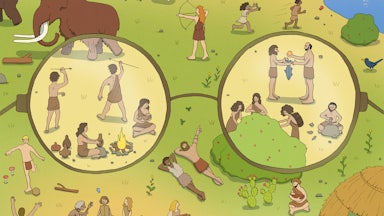This past week, Netflix dumped the first half of the third season of the Shonda Rhimes–produced Regency soap Bridgerton. Between seasons, I do not think about Bridgerton. I wouldn’t rank it high on my list of the best things Netflix has ever produced. And every time that a new season has dropped on Netflix, my first reaction has been, “Really? There’s more of this? How? Why?” But then something happens. After about a half-hour, I get locked in. All of a sudden, all I want is Bridgerton, as much as I can get. I’m invested in every will-they-won’t-they plot; I’m laughing out loud at even the mildest witticism from Eloise (Claudia Jessie); I’m remarking, to anyone who’ll listen, which actors are nailing the 1990s BBC performance style and which ones aren’t. And when I’m finished watching the season, all I can think is, “Why aren’t there forty more episodes of this available to watch right now?” Bridgerton is, in other words, a pure, perfect binge.
This form of viewing has been Netflix’s stock in trade for just over a decade now, and while the infamous binge-watch itself is the phenomenon that’s become central to its brand, the binge would not be the binge without the “dump.” Since its first hit original series, House of Cards, in 2013, and with only a very small number of exceptions, Netflix has released nearly all of its series in full-season dumps or drops. While almost everything it makes is structured and could plausibly be released in a weekly serial format, Netflix chooses to dump instead.
And others have followed. As the streaming landscape has expanded to include both streaming-only platforms like Hulu and online extensions of traditional broadcast and cable networks like Max, the dump has become a fraught choice. Why does one series get the dump, while another on the same platform gets the weekly drop? Why would FX choose to serialize its recent hit series Shōgun while dumping new seasons of its other recent hit series The Bear all at once?
Observers once predicted a future in which all TV would be dumped, ready for bingeing. Yet every time a platform has a big serialized hit—Showtime’s Yellowjackets or Disney’s The Mandalorian—there are prophecies that viewers have grown tired of the binge and that the dump is on the way out. Neither has turned out to be true. Instead, streaming has left the act of watching TV in a state of disorder, stripping away some of its most reliable pleasures, creating new modes of viewing that can be as confusing as they are comforting. Rather than ushering in a new era of TV replete with new forms and new practices of viewership, streamers have us watching the same old TV, with the same serial eyes and a lot less control.
“Netflix dumps shows because they can,” Bill Gorman told me. Gorman co-founded the popular website TV by the Numbers in 2007 and now analyzes TV and streaming ratings data online as “TV Grim Reaper.” I asked him to explain why the dump has become such a load-bearing feature of the streaming landscape. As Gorman tells it, the episode dump strategy mostly works for platforms that can afford it. Netflix, for its part, is able to release one or two original series per week. This is miles ahead of its competition. And this constant churn of new content has led to subscriber numbers that notably don’t really churn that much. Its subscriber base stably exists because of this glut of programming, not in spite of it. Each new dump clears the way for another and another and another.
But there’s also a publicity benefit. Nielsen’s public streaming ratings are calculated based on total minutes viewed per week. So dumped series have an automatic advantage against serialized ones. “The Nielsen original show public top 10s are dominated by Netflix,” Gorman notes. And “part of that is because Netflix has lots of subscribers, but even more of that is because when a show dump hits there are hundreds of minutes to watch all at once.” There’s simply more of a dumped show to watch on its debut week. This, Gorman speculates, is also why platforms other than Netflix occasionally dump their series. Most networks and streamers that aren’t Netflix have to serialize, to stretch out, to prolong their series in weekly installments precisely because they don’t have the endlessly regenerating archive Netflix does. So what used to be the primary feature of traditional television—the weekly episode—becomes the only way to hold onto subscribers. The occasional dump—like FX dumping The Bear, for instance, or Disney+ dumping Echo—might get a show on the Nielsen top 10 and bring in new subscribers that get carried along by the otherwise weekly rhythms of the linear release schedule.
Dumping might be good for ratings, but it can be bad for shows. Or, rather, it can constrain the type of reception a show gets. When The Bear was initially dumped, plenty of commentators—including me—bemoaned the decision. A weekly release, we reasoned, might have led to whole weeks of conversation devoted to knockout episodes, hastily compiled oral histories of stunt casting heroics, a full seven days to process the beauty of “Forks.” Here was a show that had all the elements of appointment television, being released in a way that didn’t capitalize on any of that. Succession had just spent weeks unfurling every Sunday to an obsessed audience, and The Bear seemed to be giving up all that extended pleasure for a momentary P.R. opportunity.
Dumps, for all the concentrated bursts of enthusiasm and attention they generate, seem to threaten a communal TV culture. And as generations of viewers who never experienced anything other than streaming—who grew up with on-demand cartoons and episode dumps of all their favorite teen dramas—come to dominate the discourse about and, eventually, the production of this medium, it seems ever more possible that a whole style of reception will disappear. I don’t know if we will eventually judge the cultures that grew up around these weekly rituals to have been good ones, but they will be history nonetheless.
Of course The Bear isn’t the first serial-style show to be distorted by streaming. Long before streamers began to produce original content, they popularized bingeing by streaming full seasons of those silver age TV delicacies like Mad Men and Breaking Bad—shows that originally aired on AMC in serial form. And it’s possible to watch The Bear the same way we watched those shows, paying attention to its serial structure even though it’s not on a serial release schedule. In fact, some of that show’s most innovative or laudable qualities are the ways that it makes each episode feel distinct from the previous one, by bouncing back and forth between character-focused and ensemble episodes. Just because we can binge it doesn’t mean we have to. And even if we do, part of the pleasure still comes from the show’s genetic seriality.
It is, in fact, notable how many dumped shows still conform to the serial structures of the weekly model, even though they’ll never occupy it. They rarely take formal advantage of the relative lack of constraint that streaming ought to allow. Hits like Stranger Things might balloon episodic runtimes, and shows like Reservation Dogs
or Somebody Somewhere might exercise a loose hand with plotting, but they don’t fundamentally disrupt the basic narrative architecture of a serial drama. A change in format or platform might initially have seemed to prompt radical reimaginings of the form, yet they didn’t end up changing much at all. The industry has “disrupted” any number of seemingly sacred aspects of production and distribution, but the constraints of conventional serial structure have proven pretty hard to shake.
And that’s as true for viewers as it is for creators. The binge-watcher consumes wantonly, sure, but in doing so, the binge-watcher also organizes, lends intimate, personalized structure to a show that is offered up with only lightly suggested starts and stops. This narrative organization is beholden to cues within the show but also to personal stress, the constraints of free time, the desire to keep one moment of comfort going, the desire to forestall a moment of dread, the zombie-like power of revenge bedtime procrastination, the ultimate biological power of sleep, the passage of time.
We know how to watch serially even if what we’re watching isn’t presented that way. And we know this because serial television is and always has been a social practice, even when we do it alone. As the media scholar Shane Denson puts it, “in serial formats, our own temporal becoming is intricately interwoven with the temporal unfolding of the series.” The form and content of the television mirrors and even becomes the form and content of our lives. Physically intimate and virtually social, there’s a vanishing boundary between our viewing of these shows and the rest of our lives. But the serial elements we project upon these shows or perceive within them are vestigial, phantom interactions with ghostly friends. We watch the dump alone, in relation only to ourselves and our impulses and our desires, without even the pretense of TV’s social promise.
In a 2022 quarterly earnings letter to shareholders, Netflix wrote this about its dump model: “We believe the ability for our members to immerse themselves in a story from start to finish increases their enjoyment but also their likelihood to tell their friends, which then means more people watch, join and stay with Netflix.” The language of “immersion” in a story is not unique here, as it’s a central aspect of everything from classical Hollywood style to twenty-first-century prime-time serial drama. What’s interesting is the implication that a dumped series is uniquely able to allow viewers to become immersed in the story. In an epic film of the 1950s or a gripping antihero drama of the 2000s, viewers become immersed in the world of the text, but they do so within the structure that the creators design and the medium allows. The immersion of the binge, the immersion that is unique to the dump and the binge, is one that invites only the participation of the viewer. The viewer decides when the story pauses, which episodes air on their own or in part, which ones are grouped together. The viewer decides these things not according to the constraints of serial form but according to the constraints of the lives they lead outside of the show.
The hit series like Grey’s Anatomy and Scandal and How to Get Away With Murder that won Shonda Rhimes the lucrative Netflix deal that has resulted in Bridgerton were perhaps the greatest examples of serial television’s social potential—in terms of both the quality of the shows and their economic impact. The writers of the Shondaland empire took their online fandoms incredibly seriously, live-tweeting, doing Q&As, engaging with viewers through social media as a matter of policy. And the shows reflected this. It can be fun to binge a season of Scandal, but it’s also strangely difficult. The shows move at a breakneck pace, knowing precisely how much viewers can take for 45 minutes at a time. They feature twist after twist after twist, knowing that viewers viewing in real time will turn to their apps or their group texts to discuss. They are built to supercharge the energy of their time slot. Bingeing four Scandal episodes in a row on a streamer—out of their native, weekly habitat—is thus a disorienting, disembodied experience. This is TV that’s excessive by design, but it doesn’t necessarily feel that way until you binge it alone.
Bridgerton, at its best, has the same breathless energy as those earlier Shondaland hits. And it has certainly found its fans online (overlapping fascinatingly with the preexisting fandom of the romance novels it adapts). But it doesn’t exist in time like those other shows. It’s shorter, in terms of raw numbers, but it’s also quicker in an aesthetic sense. Sure it teases a little bit and it throws obstacle after obstacle in the way of its leads, but each season is transparently a journey of two characters toward marriage, and that marriage plot speeds forward with great efficiency. Scandal and Grey’s moved fast, but they did so within an ever-expanding, increasingly unwieldy narrative landscape. As Bridgerton barrels toward its resolution each season, it becomes less messy, less surprising, less contingent until the thing we knew would happen all along finally does. Even for fans of the show, it’s hard to say that there’s not something lost here, that, as contrived and constructed the “social” life of a television viewer is in relation to their favorite weekly story, the viewer of the dump is substantially more alone, more lonely in their pursuit.
This season has been notably split into two halves that will dump one month apart. This strategy seems built to maximize those Nielsen numbers, certainly, but also, I suspect, to try to recreate some of that social experience lost in translation from Scandal to Bridgerton. The dump fundamentally undermined the social life that TV could have as a medium, instead offering the viewer greater freedom and choice. But TV has never been about unlimited choice, and its freedoms have always been circumscribed. TV has always been about the pleasurable, frustrating, illuminating management of time, not our liberation from its constraints. The dump removes that constraint, and with it something essential to the medium. And it leaves us, profoundly, to our own devices.






